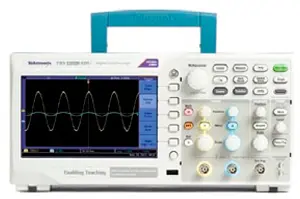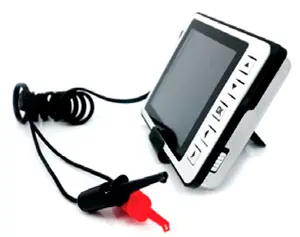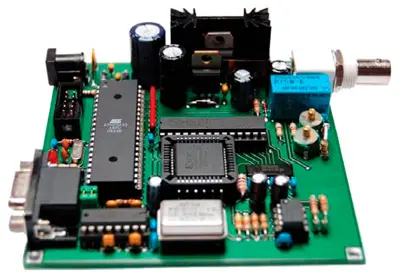Digital oscilloscopes, being expensive, have always been out of reach for many. But this doesn’t make them less desirable. Fortunately, test and measurement companies have sensed this situation and started developing low-priced oscilloscopes with reasonable quality and features. So we now have several wonderful low-budget options. Let us take a look at some of them.
A good oscilloscope is an indispensable tool for you if you are seriously into electronics. The oscilloscope helps you check the functioning of electronic circuits better. With advancements in technology, electronics designing, testing and even repairing has become much more challenging than before. Engineers thus require advanced tools to solve measurement challenges quickly and accurately, and a digital storage oscilloscope helps them do just that. But, due to its high price, this equipment has always been out of reach for most individuals.
The strong desire of the engineers to possess a good oscilloscope has led companies such as Tektronix, Agilent and Teledyne LeCroy to introduce low-priced oscilloscopes that promise reasonable acquisition quality and performance. Generally, these look like a standard oscilloscope with integrated display for viewing the acquired signal as shown in Fig. 1.

Fig. 1: An oscilloscope with integrated display
Another low-cost solution comes from companies such as Digilent, Virtins Technology, Link Instruments, Parallax Inc. and Velleman Inc., which uses processing power of a computer and its monitor to display the acquired signal. These solutions are becoming more popular as they are compact yet show the signal on a larger display of a computer for better analysis. Some of these are even multifunctional, with additional functions of waveform generator, logic analyser, DC supply and multimeter. Fig. 2 shows such a system.

Fig. 2: An oscilloscope that shows signal on a computer's screen
Next are the small pocket-size oscilloscopes that can be highly useful for field engineers. Most of these are low-priced. Though their accuracy is not as good as the previous options but these are good enough for basic analysis. Fig. 3 shows a pocket-size oscilloscope.

Fig. 3: A pocket-size oscilloscope
There are also various open source do it yourself (DIY) oscilloscope designs available on the Internet. You can build these systems yourself and use for basic test and measurement. Such systems are very useful for students as they learn a lot while building their own oscilloscope and then use it with better confidence. Fig. 4 shows such a system.

Fig. 4: A DIY-type oscilloscope
TABLE I. Some Low-Budget Oscilloscope Options
Specifications | Tektronix TBS1052B-EDU | Agilent DSO1052B | Gwinstek GDS-1052-U | Rigol DS1074Z | Teledyne leCroy 940-WAVEACE1001 |
Bandwidth | 50MHz | 50MHz | 50MHz | 70MHz | 40MHz |
Sample rate | 1.0GS/s | 2.0GS/s half channel interleaved, 1 GS/s all channels | 250MS/s maximum | 1GS/s | 1GS/s (interleaved) |
External trigger | Yes | Yes | Yes | Yes | |
Number of channels | 2 | 2 | 2 | 4 | 2 |
Automated waveform measurement | Yes | Yes | Yes | Yes | Yes |
Waveform math | Yes, FFT | Yes, FFT | Yes, FFT | Yes, FFT | |
I/O interfaces | USB, GBIP (optional) | USB | USB | USB | USB |
Display size | 17.8cm (7 inches) | 14.7cm (5.7 inches) | 14.7cm (5.7 inches) | 17.8cm (7 inches) | 17.8cm (7 inches) |
Overall dimensions | 326mm x 158mm x 124mm | 324.6mm x 157.8mm x 129.2mm | 310mm x 142mm x 140mm | 313.1mm x 160.8 mm x122.4mm | 163mm x 313mm x 115.8mm |
There are so many options available for each type of oscilloscope. But before looking at these options to evaluate which one suits your requirement, you need to understand their specifications. You can have correct measurements only when your oscilloscope's specifications support the range of the signals you are trying to measure. Some of the important specifications are:
Bandwidth. It determines the maximum frequency signal that the oscilloscope can accurately measure. The accuracy decreases with increase in signals' frequency. The bandwidth mentioned in the datasheet (say, 100MHz) is actually the frequency at which a sinusoidal input is attenuated to 70.7% of its true amplitude. Beyond this frequency the oscilloscope cannot support reasonable accuracy. To decide how much bandwidth you need, find out what would be the range of frequencies you would need to measure. Once you know the frequency range, just use the 'five times' rule, that is, multiply the maximum frequency by five and you have the bandwidth that you need to accurately measure those signals.
Rise time. Rise time is the time taken by a signal to change from a specified low value to a specified high value. Typically, these values are 10% and 90% of the step height. As a thumb rule, similar to bandwidth, the rise time of the oscilloscope should be less that 1/5 of the fastest rise time of the signal to accurately measure it.
Sample rate. Sample rate refers to how frequently a digital oscilloscope takes a sample of the signal. The faster an oscilloscope samples, lesser the details lost while reconstructing the signal. In order to accurately reconstruct a signal and avoid aliasing, the Nyquist theorem states that the signal must be sampled at least twice as fast as its highest frequency component. This theorem assumes an infinite record length and a continuous signal, but no oscilloscope can offer infinite record length. Therefore sampling at only twice the rate of the highest frequency component will not be sufficient.
The sampling rate that you might require £ Ш1 to accurately read your signal will majorly depend on the method used for reconstructing the signal, also called interpolation. For accurate reconstruction using sin(x)/x interpolation, sample rate should be at least 2.5 times the highest frequency component of your signal. Using linear interpolation, the sample rate should be at least 10 times the highest frequency signal component.
Record length. The oscilloscope cannot store infinite number of samples as assumed by Nyquist equation. Record length determines the time that can be captured by each channel of the oscilloscope.
Time captured = Record length/ Sample rate
Normally, an entry-level oscilloscope comes with 2k to 2.5k points, which is more than enough. In general, greater record length is better. To capture and debug serial bus you will need record length as high as 1M points.
External trigger. External triggers allow you to stabilise repetitive waveforms and make them appear static on the display by continuously displaying the same section of the input signal. Generally, oscilloscopes are available with edge and pulse-width trigger. But advanced triggering options like A and B sequence, video, communication (CAN, SPI, etc) and logic triggering can help you debug faster.
Waveform capture rate. Sample rate indicates how fast the oscilloscope samples the input signal within one waveform, but waveform capture rate refers to how quickly an oscilloscope captures a waveform. The oscilloscopes with better waveform capture rate capture fast transients better.
Probe specifications. Probes' specifications are as important as that of oscilloscope. The probe's bandwidth should match the bandwidth of the oscilloscope. Here also the five time thumb rule works perfectly.
The probe will be in direct contact with the circuit and should not overload it. Otherwise, the measurements will not be correct. Resistive loading greater than 10M-ohms and capacitive loading less than 10pF is acceptable for a probe.
Integrated display type oscilloscope
Table I show some low-budget integrated-display oscilloscopes available from different manufacturers, including their brief specifications. The bandwidth you can get in this budget will mostly be less than 100MHz, which is more than enough for basic analysis and testing, if you go by 'five times' thumb rule discussed earlier. And you get a lot of advanced features of expensive oscilloscopes, such as math functions and USB storage, also with these oscilloscopes.
Being mostly compact in size, these can be used as bench-top oscilloscopes and also moved easily, if required. Their display size ranges from 12.7cm to 17.8cm (5 to 7 inches), which is enough for proper viewing. But some vendors boast of utilising the same space more efficiently with advanced features like auto-hide menu panel and sectional zooming.
PC-based oscilloscopes
A PC-based oscilloscope is normally a small piece of hardware that is attached to a computer to acquire the signal and show it on the computer's display. In most cases the power supply too is derived from the computer's USB port, which makes them very handy and easy to carry along. A lot of multifunction options are also available, such as additional signal generator, logic analyser, multimeter, 5V DC supply, digital I/Os and spectrum analyser.
The multifunction oscilloscopes are perfect for students and hobbyists, who do not require higher accuracy but need all the tools at one place. Availability of the signals on a bigger display is also a treat for the eyes. The window software for these oscilloscopes provide analysis and storage tools. Table II shows some of the PC-based systems available in the market.
TABLE II. Some PC-Based Oscilloscopes
Manufacturer | Model | bandwidth Sample rate | Multifunction |
Dynoninstruments | ELAB-080 | 60MHz 80MS/s | Yes |
Bitscope | BS50 | 70MHz 40MS/s | Yes |
Virtins Technology | VT DSO-2820R | 80MHz | Yes |
Link Instruments | MSO-19 | 60MHz Repetitive mode: 1GS/s | Yes |
Single shot: 200MS/s | |||
Jyetech | DSO 094 (Dual channel) | 10MHz 50MS/s | No |
Parallax | PropScope USB Oscilloscope | 25MS/s | Yes |
Picotech | PicoScope 2104 | 10MHz Repetitive mode: 1GS/s; Single shot: 50MS/s | Yes |
Dynoninstruments | S2X100 | 50MHz 100MS/s | Yes |
Easysync | DS1M12 | 250kHz Repetitive mode: 20MS/s | Yes |
Synchrotech | USB-SCOPE50 | 75MHz 1GS/s | No |
Pocket-size oscilloscopes
Pocket-size oscilloscopes are easy to carry along and normally work on battery. The frequency range that you get in these oscilloscopes is limited. Some expensive ones do support signals in megahertz range but the low-budget ones are normally for kilohertz range only. So these cannot be used for debugging high-frequency signals; they only support basic testing and are very handy in field work.
Some of these also come with wireless connectivity, such as Bluetooth. Using them you can view the signals remotely within a defined distance. There are a few that you can connect to you Android device and view the signals wirelessly. Table III shows some of the pocket-size oscilloscopes from different vendors.
TABLE III. Some Pocket-Size Oscilloscopes
Manufacturer | Model | Bandwidth | Sample rate |
Jyetech | DSO 094 (Dual channel) | 10MHz | 50MS/s |
Velleman | APS230 | 2 x 30MHz | 240MS/s |
Velleman | HPS10 | 2MHz | 10MHz |
Velleman | HPS50 | 12MHz | 40MHz |
Velleman | PPS10 | 2MHz | 10MS/s |
uni-trend | UT81B | 8MHz | 40MS/s |
Seeedstudio | DSO Nano v2 | 0-200kHz | 1MS/s |
Seeedstudio | DSO Nano v3 | 0-200kHz | 1MS/s |
DIY-type oscilloscopes
Lot of designs are available on the Internet to build oscilloscopes yourself and use them for basic testing. In most cases, complete designs including schematic, layout and source code are available. Their performance, however, will depend on the quality and proper assembly of the components.
DIY-type oscilloscopes are mainly microcontroller based. The most popular microcontrollers for oscilloscopes belong to AVR and PIC series. Their frequency range also is not very high. Some of them display the signals on a computer monitor while others have integrated LCD displays. Those using computer monitor for display are more comfortable than those with integrated displays. Table IV shows some of the DIY-type oscilloscopes.
TABLE IV. Some DIY-Type Oscilloscopes
Model | Bandwidth | Sampl rate | Website link |
AVR DSO | 10MHz | 50MS/s | http://www.ulrichradig.de/home/index.php/avr/avr-dso |
DSOA Mk3 | 5MHz | 20MS/s | http://alternatezone.com/electronics/dsoamk3.htm |
eOscope | 20MHz | 40MS/s | http://www.eosystems.ro/index.php/projects/eoscope |
06201P | 1MHz | 5MS/s | http://www.jyetech.com/Products/LcdScope/eDSO062.html |
PIC12F675 Oscilloscope | http://www.semifluid.com/2006/01/31/pic12f675-oscilloscope/ | ||
PPMScope | 500kHz | 1MHz | http://jonw0224.tripod.com/ppmscope.html |
SX28 | http://www.sxlist.com/techref/ubicom/sxoscope/index.htm |
From all the above types and options, choose the one that suites your taste and requirements. All the oscilloscopes offer reasonable quality, including the DIY ones. However, one from a reputed manufacturer is more likely to give accurate measurements and performance.
It is only the beginning; we are likely to see a lot of better and cheaper options in future.
Author: Ankit Gupta

